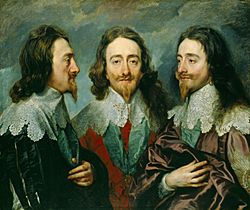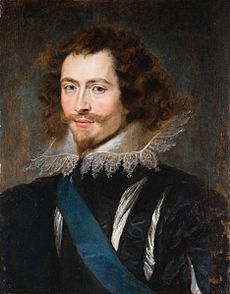Timeline of the Wars of the Three Kingdoms facts for kids
This is a timeline of the major events that led to, happened during, and followed the Wars of the Three Kingdoms. These wars were a series of conflicts across England, Scotland, and Ireland in the mid-1600s. They involved struggles for power between the King and Parliament, and disagreements over religion.
The 1620s: King Charles I Takes Power
1625: A New King and Early Problems
- 27 March: After his father, King James I, died, Charles I became King.
- 13 June: Charles married Henrietta Maria, a princess from France. Many people did not like this because she was Catholic.
- 8 June–12 August: Charles held his first Parliament meeting. It was called the "Useless Parliament" because it did not achieve much. Parliament wanted to limit the King's power. They only allowed him to collect certain taxes, called tonnage and poundage, for one year. Usually, kings could collect these taxes for their whole lives.
- October: To get more money, King Charles made a rule in Scotland called the Act of Revocation. This rule took back land that kings or the church had given to nobles in the past.
1626: Parliament Challenges the King
- 6 February–15 June: Charles's second Parliament met. Instead of talking about money, Parliament wanted to remove one of the King's close friends, the Duke of Buckingham. Because of this, Charles ended the Parliament meeting.
- October: Charles tried to get money without Parliament's approval. He demanded a 'forced loan' from people to pay for a war against Spain.
1628: The King Signs a Key Document
- 17 March: Charles's third Parliament began.
- 7 June: The King signed the Petition of Right. This was a law forced on him by Parliament. It said that the King could not collect taxes without Parliament's approval or imprison people unfairly.
1629: Charles Rules Alone
- 2 March: The Speaker of the House of Commons tried to end the Parliament meeting as the King wanted. But members of Parliament held him in his chair. They then passed motions against unfair taxes and changes to religious practices.
- 10 March: The King was so angry that he ended Parliament. He decided to rule without them. This period was known as the Personal Rule, lasting for 11 years.
The 1630s: Religious Fights Begin
- 1637: King Charles I tried to make the Presbyterian Church of Scotland use Anglican church services, which were different. This caused riots, with one famous moment involving Jenny Geddes.
- 1638: Many Scots signed the National Covenant. This was an agreement to protect their Presbyterian religion.
- 1639: Fighting started in Scotland between the Covenanters (who signed the Covenant) and the Royalists (who supported the King). The Covenanters took the city of Aberdeen in February.
- 1639: The Bishops' War began. Charles brought his army to Scotland but decided to talk instead of fight. They signed the Treaty of Berwick on 18 June 1639.
The 1640s: Civil War Erupts
- 1640: Charles called the English Parliament back to get money for his fight with Scotland. Parliament agreed to give him money, but only if he listened to their complaints about his 11 years of "Personal Rule." Charles refused and ended Parliament after just three weeks. This was called the "Short Parliament".
- 1640: The Second Bishops' War started in August. The Covenanters marched into England and defeated an English force at the Battle of Newburn on 28 August 1640. They then took the city of Newcastle.
- 1640: The Treaty of Ripon on 26 October 1640 meant the Scots kept Newcastle and received a large payment from Charles. Charles had no choice but to call Parliament again to get the money. This Parliament started in November and lasted until 1660, earning it the name "Long Parliament".
- 1641: 23 October: The Irish Rebellion broke out in Ulster. There was violence against Protestants by Catholics. The rebels won a battle against the King's forces at Julianstown Bridge in December.
- 1641: 1 December: Parliament sent the Grand Remonstrance to Charles. This was a list of complaints. Charles refused to address them.
- 1642: The Covenanters sent a Scottish army to Ulster to protect the Protestant settlements, called plantations.

"Charles I, King of England, from Three Angles" by Anthony van Dyck
- 1642: Charles entered the House of Commons with armed soldiers to arrest five members of Parliament he accused of treason. This caused a huge uproar in London, and Charles fled the city fearing for his life.
- 1642: In Charles's absence, Parliament passed the Militia Ordinance. This law took control of London's weapons and placed the local militias, called Trained bands, under Parliament's power. Charles responded by appointing his own people to control other regional militias. Both sides then actively began gathering troops and weapons.
- 1642–1646: The First English Civil War began.
- 1642: An alliance of Irish Catholics, including Gaelic Irish and the Old English, formed the Catholic Confederation. They met first in March 1642 in Kilkenny.
- 1642: 23 October: The Battle of Edgehill, the first major battle of the English Civil War, ended with no clear winner.
- 1643: A ceasefire was declared between the English Royalists and Irish Confederates.
- 1643: 25 September: The English Parliament and Scottish Covenanters formed an alliance called the Solemn League and Covenant. Scottish troops marched into England to help Parliament.
- 1644: 2 July: The Battle of Marston Moor was a major defeat for the Royalists by the Parliamentarians and Scots.
- 1644: The Scottish Civil War started. It was led by the Scottish Royalist Montrose, with help from Irish Confederate troops.
- 1645: The English Parliament created the New Model Army. This was a well-trained and disciplined army.
- 1645: 14 June: The Battle of Naseby: The New Model Army crushed the Royalist army. This battle effectively ended the First English Civil War.
- 1645: 15 August: Montrose won control of Scotland for the Royalists at the Battle of Kilsyth. However, Covenanter armies returning from England defeated him at the Battle of Philiphaugh on 13 September 1645.
- 1646: May: Charles I surrendered to the Scots Covenanters, who then handed him over to the English Parliament.
- 1646: 5 June: In the battle of Benburb, an Irish Confederate army defeated the Scottish Covenanter army in Ulster.
- 1647: In the Battle of Dungans Hill (August) and the Battle of Knocknanauss (November), English Parliamentarian forces heavily defeated the Irish Confederate armies.
- 1648–1649: The Second English Civil War took place.
- 1648–1649: The Ormonde Peace was a formal alliance between Irish Confederates and English Royalists. This caused some Confederates to split and join forces with Cromwell's army.
- 1648: The Battle of Preston (August): A Scottish Covenanter army invaded England to try and bring Charles I back to power. They were defeated by the Parliamentarians.
- 1649: 30 January: King Charles I was executed by the English Parliament.
- 1649: 2 August: In the battle of Rathmines, Parliamentarians defeated an Irish-Royalist force outside Dublin.
- 1649: 15 August: The New Model Army landed in Ireland, beginning the Cromwellian conquest of Ireland.
- 1649: 11 September: Cromwell's forces took Drogheda, followed by Wexford on 11 October.
The 1650s: Cromwell and the End of the Wars
- 1650: Montrose tried to start a Royalist uprising in Scotland. The Covenanters defeated, arrested, and executed him.
- 1650: Charles II swore an oath to support the Solemn League and Covenant. He also ended his alliance with the Irish Confederates. The Scots crowned him King at Scone on New Year's Day, 1651.
- 1650: The Third English Civil War began between the Scots and the English Parliament. Cromwell invaded Scotland and heavily defeated the Scottish army at the Battle of Dunbar on 3 September 1650.
- 1651: Henry Ireton began a siege of Limerick.
- 1651: June: Admiral Robert Blake captured the Isles of Scilly.
- 1651: 3 September: The defeat of Charles II and the Scots at Worcester ended the Third Civil War. Charles II went into exile in France.
- 1652: The last major Irish stronghold in Galway surrendered, but smaller fights continued.
- 1653: The last organized Irish troops surrendered in Cavan.
- 1654: The Royalist uprising in Scotland, which had been going on since 1651, finally ended.
- 1655: March: The Penruddock uprising took place in southwest England.
- 1658: 3 September: Oliver Cromwell died. His son, Richard, took over as Lord Protector.
- 1659: August: Booth's Uprising occurred along the Welsh border.
The 1660s: The Monarchy Returns
- 1660: 25 May: Charles II landed at Dover. This marked the start of the Restoration, bringing the monarchy back to England, Scotland, Ireland, and the English colonies.
- 1661: 1–4 January: Venner's Uprising took place in London.

All content from Kiddle encyclopedia articles (including the article images and facts) can be freely used under Attribution-ShareAlike license, unless stated otherwise. Cite this article:
Timeline of the Wars of the Three Kingdoms Facts for Kids. Kiddle Encyclopedia.

